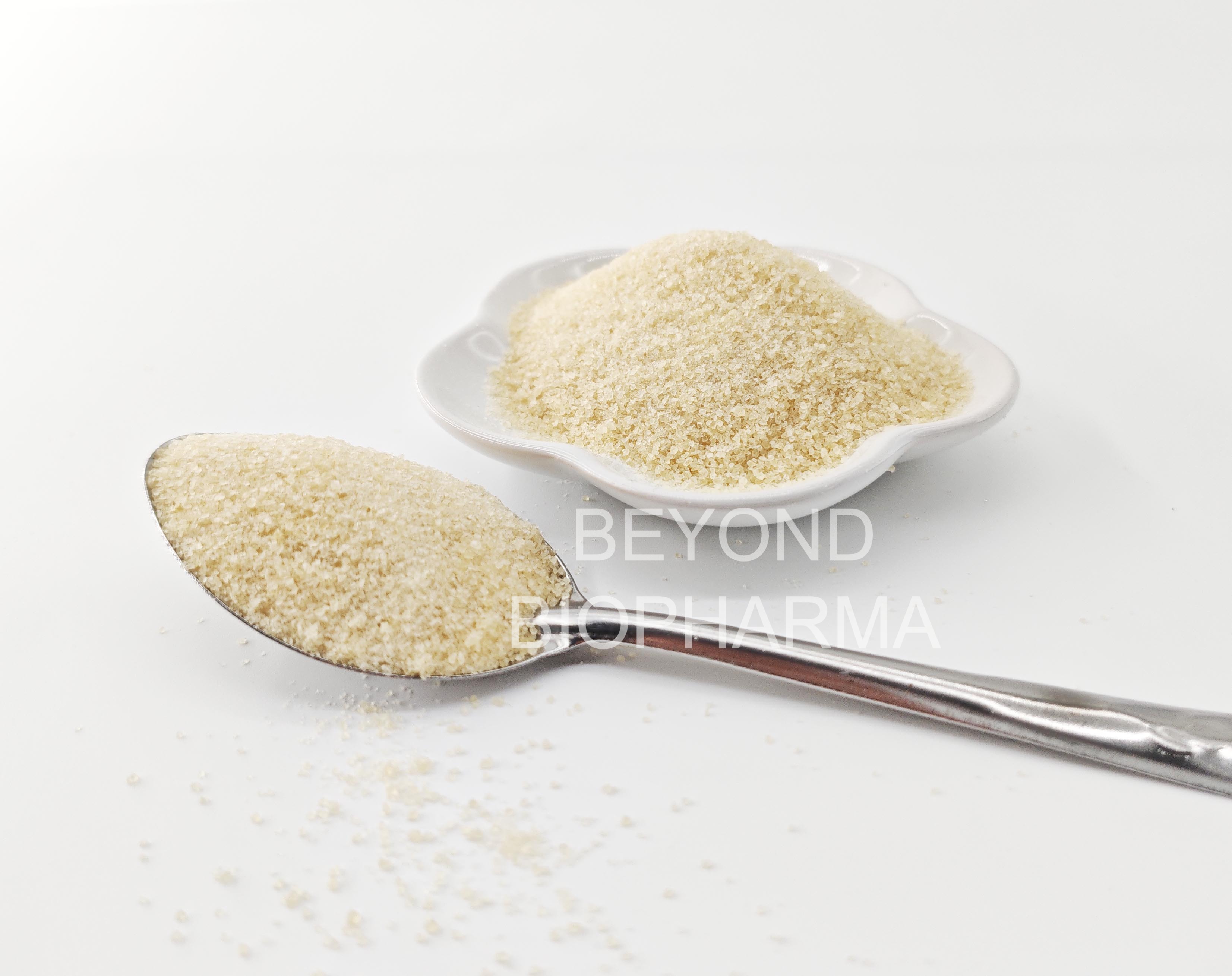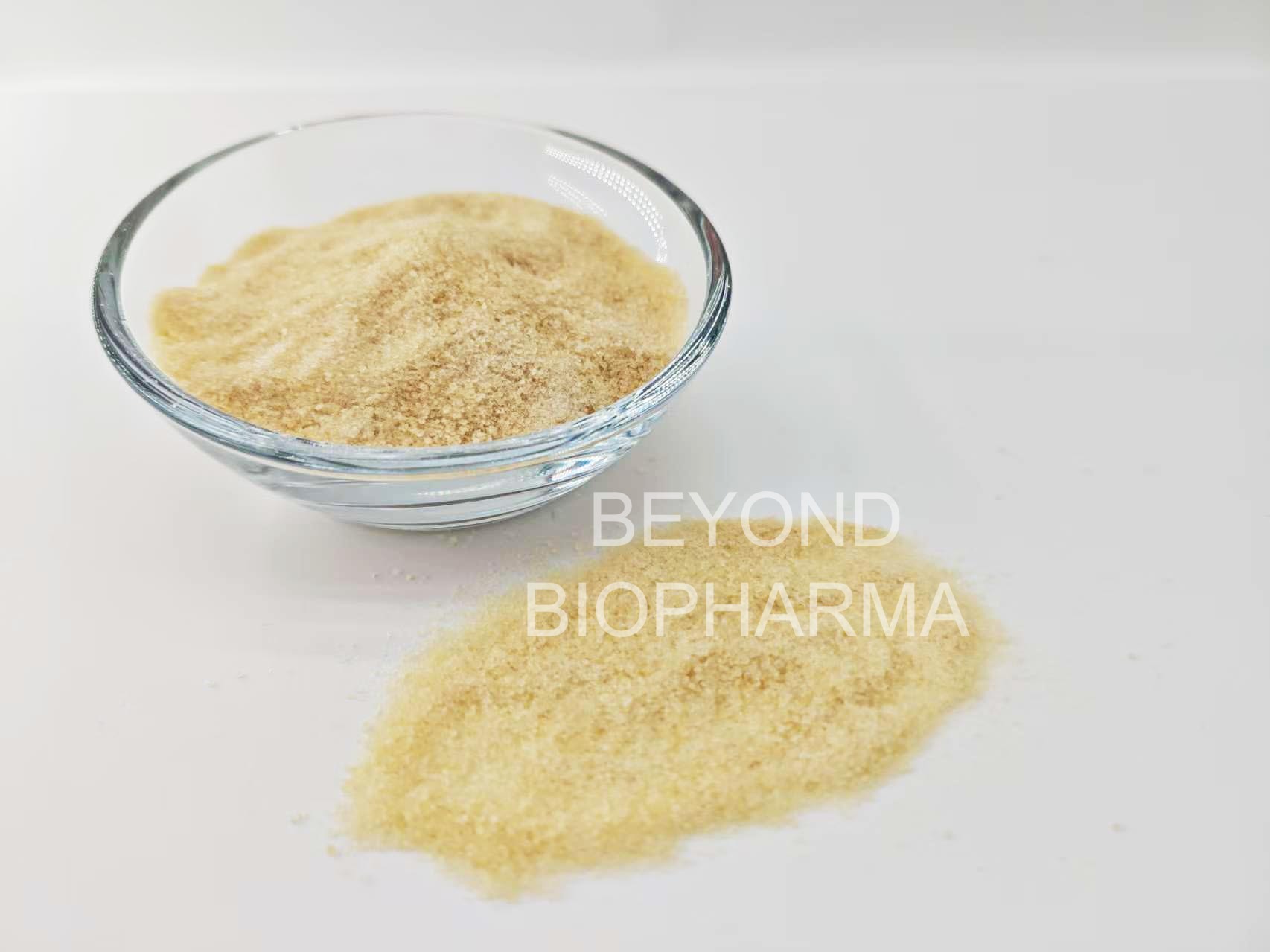Gelatin, a hydrolyzed product of collagen, is a fat-free, high-protein, cholesterol-free substance. It serves as a natural, nutritious food thickener. Consuming it does not cause weight gain or weaken physical strength. Gelatin is also a powerful protective colloid with strong emulsifying properties. Once in the stomach, it inhibits the aggregation of proteins in foods like milk and soy milk caused by gastric acid, thereby facilitating digestion.
I. Composition and Properties of Gelatin
Gelatin protein contains 18 amino acids, seven of which are essential for the human body. Excluding less than 16% water and inorganic salts, gelatin comprises over 82% protein, making it an ideal protein source. Finished gelatin appears as colorless or pale yellow, transparent flakes or microparticles. Gelatin is insoluble in cold water but slowly absorbs water to swell and soften. Gelatin can absorb 5 to 10 times its weight in water. Gelatin's physical properties vary significantly depending on its source, with pigskin gelatin offering superior properties, including high transparency and excellent plasticity.
Gelatin dissolves in hot water, forming a thermoreversible gel. It possesses exceptional physical properties, including gelling strength, compatibility, high dispersibility, low viscosity, dispersion stability, water retention, coating properties, toughness, and reversibility. Therefore, gelatin is an important food additive, widely used as a gelling agent, stabilizer, thickener, foaming agent, emulsifier, dispersant, and clarifier.


II. Gelatin Applications in Candy
It is reported that over 60% of gelatin produced worldwide is used in the food and confectionery industry. In candy production, gelatin is used to produce soft candies such as toffee, meringue, marshmallow, jelly candy, crystal flower candy, and gummy candy. Gelatin acts as a water absorbent and provides a structural support. When dissolved in water, gelatin particles attract and intertwine, forming a layered network structure. This network structure agglomerates as the temperature drops, completely enclosing the sugar and water within the gel's interstices. This allows the soft candy to maintain its stable shape and resist deformation even under heavy loads. Gelatin can reduce sugar crystal size and prevent the separation of oil and water in syrups. Used as an emulsifier and binder in candy manufacturing, it reduces brittleness, facilitates shaping, and makes cutting easier, thus preventing breakage and improving the yield of various candies.
The typical dosage of gelatin in candy is 5% to 10%. A 6% gelatin dosage is most effective in flower candies, 6.17% in gummy candies, 0.16% to 3% or more in nougat, 1.15% to 9% in thick syrups for candy mucilage, and 2% to 7% in flavorings or date candies. In candy production, gelatin is more elastic, tough, and transparent than starch or agar. High-quality gelatin with strong gelling strength is particularly important for producing elastic, full-bodied soft candies and toffees.
III. Key Points for Making Gelatin Gummy Candies
Gelatin's fibrous protein is easily damaged by acids and alkalis, eventually losing its fibrous properties and altering its properties. The changes in gelatin caused by acid and alkali reactions occur in water, transforming it into peptone and amino acids. Therefore, it's important to consider the impact of acid in the gelling material on gelatin's gelling properties.
When selecting gelatin, consider gelling strength. High-quality gelatin will gel at concentrations below 1%. At concentrations of 4% to 5%, the gelling strength is sufficient to withstand a load of approximately 500g per square centimeter. Viscosity is used to control gelatin quality in gelatin production. High water absorption results in high viscosity, so the selected gelatin strength must meet applicable production standards. Important considerations in gelatin gummy candy recipes include the amount of gelatin used and the choice of anti-crystallization agents.
The amount of gelatin used directly affects the texture of soft candies. A small amount results in a softer texture, while a large amount increases elasticity and toughness. However, excessive toughness can be unpleasant to the taste buds. Therefore, the amount of gelatin used must be appropriately controlled. Generally, the gelatin dosage for soft candies is around 5%, while for more elastic candies, it's around 8%. For candies with greater toughness, the gelatin dosage should be above 10%. The anti-crystallization agent used in soft candies is generally starch syrup, while gelatin candies often use invert sugar syrup. This is because gelatin sols have a high viscosity, and starch syrup also has a high viscosity. After a slight cooling, the viscosity of the syrup often affects mold forming. Therefore, replacing part of the starch syrup with invert sugar syrup can reduce the viscosity of the candy syrup.
Gelatin is a protein colloid, so the effects of acid, alkali, and temperature on protein will generally have a certain impact on gelatin. In the production of soft candies, fruit flavors are generally the primary focus. The melting and dehydration processes are all completed under heated conditions, which inevitably affects the strength and viscosity of the gelatin. Therefore, in the actual production of gelatin soft candies, it is important to carefully control the pH of the material, the heating temperature and time, and to select the appropriate amount and duration of gelatin addition, as well as the appropriate acidulant addition time and amount. Repeated testing based on the specific product design requirements is essential to produce a qualified product that meets the design requirements.
Post time: Jul-31-2025